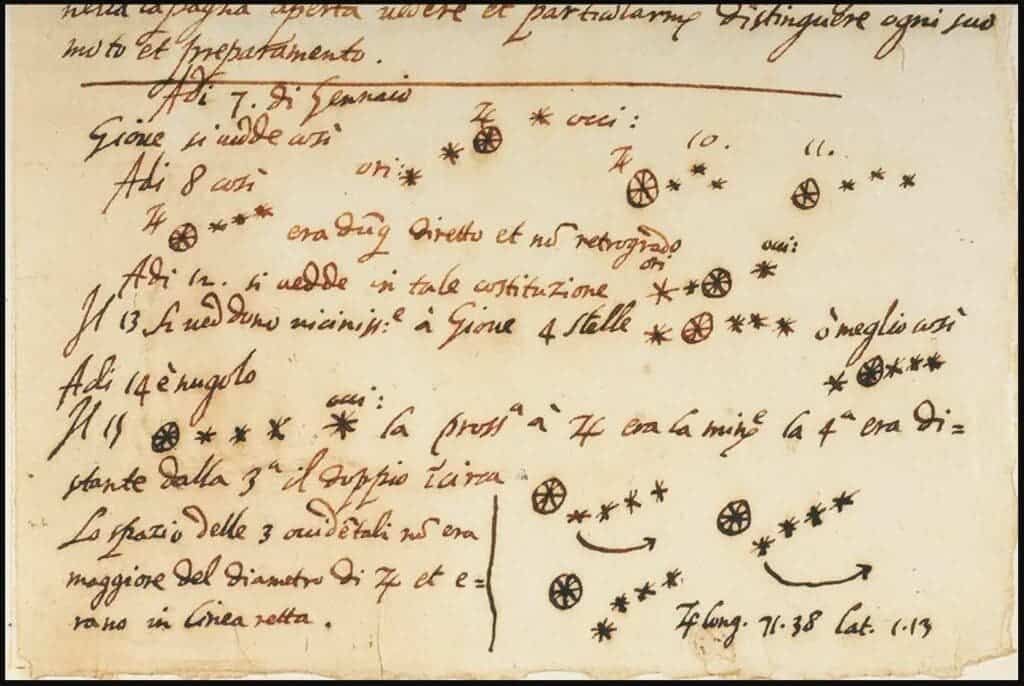Researchers at the University of Michigan sadly report that the University’s Galileo manuscript is far from genuine; instead, it is a forgery created sometime in the 20th century.

The document in question came into the University’s possession in 1938. It was donated by the trustees of Detroit businessman Tracy McGregor who, in turn, obtained the document at an auction of the possessions of the late Roderik Terry, a wealthy collector of antiquarian books and manuscripts, in 1934. In the context of that auction, it was claimed that the document had been authenticated by the Archbishop of Pisa, Cardinal Pietro Maffi (1858-1931) through direct comparison with other letters written by Galileo, which the Cardinal had in his own collection.
It seems, however, that the Cardinal’s eye was not blessed with the ability to discern a forgery, as the document was actually created in the 20th century — some 400 years after the passing of Galileo.
Incriminating watermarks
The document consists of a manuscript containing two pieces of text. The first half represents a draft of a letter that Galileo wrote in 1609, before the presentation of a new telescope he was preparing for the Doge of Venice. The lower half contains a set of notes on the moons of Jupiter.
Both of these texts have supporting material in the form of authenticated documents written by Galileo. A version of the letter in the first half of the manuscript, a final draft, is housed in the State Archive in Venezia, Italy. The final draft of Galileo’s notes on the Jovian moons is stored at the Florence National Central Library.
That being said, the document itself is not genuine, according to an internal investigation led by the University.
It all started with an email that Nick Wilding, a historian at Georgia State University, sent in May 2022. Wilding, who is working on an upcoming biography of Galileo, examined the manuscript for his work. Two elements of the document highlighted by the University of Michigan led him to have “serious doubts” as to its authenticity.
First off, the piece of paper that Galileo had supposedly written on bore the watermarks “AS,” the paper maker’s initials, and “BMO”, referring to the Italian city of Bergamo. This was a strong indicator that the paper itself was much newer than it should have been; no other document with that watermark is known to predate the year 1770, which is 150 years later than when Galileo was working on studying Jupiter’s moons.
The other worrying fact was that historians, try as they might and being “extremely thorough” in their searches of Galileo’s works, could not find any evidence of the manuscript existing before 1930. The two other documents Pietro Maffi compared this manuscript against to authenticate it were later determined to be forgeries as well, making his conclusions wildly unreliable.
“It was pretty gut-wrenching when we first learned our Galileo was not actually a Galileo,” Donna L. Hayward, the interim dean of Michigan’s libraries, told the New York Times last week.
The most likely source of the forgery, and the man Wilding suspects forged the document, is Tobia Nicotra. Nicotra was a “well-known forger”, according to university officials, and convicted of selling a fake Mozart autograph to the son of a New York Philharmonic Orchestra conductor in 1934. During Nicotra’s trial in Milan, police claimed they found evidence that Nicotra was preparing forged autographs of historical figures such as Abraham Lincoln, George Washington, Christopher Columbus, Martin Luther, Leonardo da Vinci, and Michelangelo, among others.
His modus operandi was to go to the Milan library and rip out blank pages from old books. These would then serve as the base for his forged autographs; famous musicians were his preferred figures, according to a 1934 Times article cited by the Washington Post.
And Nicotra’s legacy didn’t stop here. According to a university statement, Wilding discovered a similar Nicotra Galileo forgery in the collections of The Morgan Library in New York City. This was a letter that the famous scientist supposedly wrote in 1607. Wilding’s experience in detecting forgeries goes back to 2012, when he identified a copy of Galileo’s Sidereus Nuncius as a fake. He is currently working on checking the authenticity of other Galileo materials, and his findings will be included in his upcoming book.
In light of these discoveries, the University of Michigan Library is currently reconsidering how to present the document to the public. Although it is fake, it could still serve researchers and the public.
“In the future,” according to the library statement, “it may come to serve the research, learning, and teaching interests in the arena of fakes, forgeries, and hoaxes, a timeless discipline that’s never been more relevant.”



